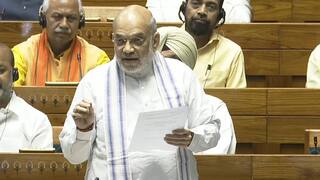Breast Cancer Awareness Month 2023: Know The Role Of Early Diagnosis And Mammography
It has been proven that early detection is the key to a cure for breast cancer. But how do we detect breast cancer early? Continue reading to know more

Breast cancer is the most common cancer occurring in women and the second most common cause of cancer-related deaths in women. In India, 1 in every 28 women is at risk of developing breast cancer. It has been proven that early detection is the key to a cure for breast cancer. But how do we detect breast cancer early? Let's have a look at the symptoms and risk factors mentioned below:
Talking about this, Dr Rucha Kaushik, who is a Consultant, Breast Cancer Surgeon, at P D Hinduja Hospital & Medical Research Centre, Mahim mentioned:
- Being a female puts all females at risk, and risk increases with increasing age; for example, 50+ women will be at more risk than 30+ women
- Family history of breast and/or ovarian cancer: if a woman has more than two immediate family relatives diagnosed with breast or ovarian cancer at a young age, then they will also have a higher risk of developing cancer than anyone without family history
- Women who are unmarried or married but choose not to have babies or breastfeed the babies will have a higher risk of developing breast cancer
- Obesity, alcohol, smoking, and unsupervised hormone therapy are among other significant risk factors
Additionally, she said that the commonest presentation is a recently noticed painless, firm lump in the breast or sometimes blood stained discharge from the breast. How do we diagnose early?
- Self-Examination: All women above the age of 25 should do a self-breast examination once a month and should report to a breast surgeon if they have any concerns.
- Annual examination by a breast surgeon
- Imaging in the form of sono-mammography [ultrasound breast] or digital mammography only if recommended by a breast surgeon.
"There are specific indications for different types of breast imaging, but due to a lack of information and awareness, women usually end up doing non-breast specific imaging too without consulting breast specialists," she added.
- For the population < 40 years of age ultrasonography breast is the choice of investigation for the diagnosis of the lump
- For > 40 years of age, if a breast surgeon suspects a lump to be cancerous, then only mammography along with ultrasound breast is advised for diagnosis
The Role Of Early Detection In Breast Cancer
Dr. Shivani Sharma, who is the Vice-President of Pathology Services & Lab Director, at CORE Diagnostics said, "Early detection plays a critical role in the fight against breast cancer, significantly improving the prognosis and survival rates of affected individuals. According to the American Cancer Society, when breast cancer is detected at an early, localised stage, the five-year survival rate is an impressive 99%. In contrast, the survival rate drops to 27% when cancer has spread to distant organs. Mammography, one of the most common screening methods, has been instrumental in early detection. It can identify tumours before they are palpable, enabling timely intervention."
"Moreover, breast self-exams and clinical breast exams by healthcare professionals contribute to early detection. The earlier breast cancer is discovered, the more treatment options are available, reducing the need for aggressive therapies and improving the overall quality of life for patients. Public awareness campaigns and regular screenings have led to encouraging results," she added.
In addition to her, Dr. Rohan Khandelwal, who is the Lead Consultant & HOD - The Breast Centre, at CK Birla Hospital, Gurgaon said, "We know that mammography and self press examination done in combination gives the best possible chance for early detection of Breast Cancer. So patients should be encouraged to be breast aware and they should go for regular check-ups as well, especially after the age of 35. Those who have a strong family history of Breast Cancer should meet the doctor to know what their risk is and what they can to reduce that risk."
Common Ways To Detect Breast Cancer:
Dr. Sohini Sengupta, who is a Medical Laboratory Director, at Redcliffe Labs listed some of the common methods to detect breast cancer:
- Mammograms: Regular mammograms are the most effective way to detect breast cancer early, especially for women over 40.
- Clinical Breast Exam: A healthcare provider checks the breasts and underarms for any lumps or other abnormalities.
- Self-Exams: Regular self-exams help women become familiar with their breasts, making it easier to notice any changes.
- MRI (Magnetic Resonance Imaging): An MRI can be used for screening in certain cases, especially for women at high risk.
- Ultrasound: An ultrasound may be used to further evaluate a suspicious area found during a mammogram or clinical exam.
- Biopsy: If a lump or abnormality is found, a biopsy is done to determine if it is cancerous.
- Genetic Testing: For individuals with a family history of breast cancer, genetic testing can assess the risk.
Role Of Mammography In Detecting Breast Cancer:
Dr. Arjun Kalyanpur, who is the Founder CEO, and Chief Radiologist at Telerad Group said, "Breast Cancer is today the most common cancer among Indian women and its incidence is on the rise. India has the highest mortality rates for breast cancer in the world, as most cases tend to be diagnosed late, in Stage III or Stage IV. The early detection of breast cancer greatly improves the chances of survival. Mammography is today the most accurate technique available for early breast cancer detection. For breast cancer rates to decline at a national level in our country, there is a need for a structured breast cancer screening program, which exists in developed countries such as the Nordic countries, the UK and the US. Such a program ( in addition to education on breast self-examination) would require screening mammography to be conducted on a large scale on an annual basis on all women over the age of 40 years, which would result in the generation of a huge number of screening mammograms for interpretation."
[Disclaimer: The information provided in the article, including treatment suggestions shared by doctors, is intended for general informational purposes only. It is not a substitute for professional medical advice, diagnosis, or treatment. Always seek the advice of your physician or other qualified healthcare provider with any questions you may have regarding a medical condition.]
Check out below Health Tools-
Calculate Your Body Mass Index ( BMI )
Trending News
Top Headlines








































